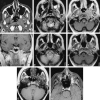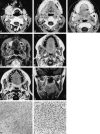Extraorbital inflammatory pseudotumor of the head and neck: CT and MR findings in three patients
- PMID: 10445457
- PMCID: PMC7056226
Extraorbital inflammatory pseudotumor of the head and neck: CT and MR findings in three patients
Abstract
We review the clinical history and imaging (CT and/or MR) studies in three patients with histologically proved extraorbital inflammatory pseudotumor of the head and neck. The imaging findings in all three cases were nonspecific, mimicking a malignant tumor or granulomatous disease.
Figures



Similar articles
-
Imaging findings of head and neck inflammatory pseudotumor.AJR Am J Roentgenol. 2009 Oct;193(4):1180-6. doi: 10.2214/AJR.09.2398. AJR Am J Roentgenol. 2009. PMID: 19770345 Review.
-
Head and neck inflammatory pseudotumor: Case series and review of the literature.Neuroradiol J. 2016 Dec;29(6):440-446. doi: 10.1177/1971400916665377. Epub 2016 Sep 20. Neuroradiol J. 2016. PMID: 27650653 Free PMC article. Review.
-
Kimura disease: CT and MR imaging findings.AJNR Am J Neuroradiol. 2012 Apr;33(4):784-8. doi: 10.3174/ajnr.A2854. Epub 2011 Dec 15. AJNR Am J Neuroradiol. 2012. PMID: 22173767 Free PMC article.
-
Pediatric inflammatory pseudotumor of the stomach: contrast-enhanced CT and MR imaging findings.AJR Am J Roentgenol. 1996 Oct;167(4):919-20. doi: 10.2214/ajr.167.4.8819383. AJR Am J Roentgenol. 1996. PMID: 8819383 No abstract available.
-
Unusual CT and MR findings of inflammatory pseudotumor in the parapharyngeal space: case report.AJNR Am J Neuroradiol. 2001 Aug;22(7):1394-7. AJNR Am J Neuroradiol. 2001. PMID: 11498435 Free PMC article.
Cited by
-
[Imaging of nasopharyngeal diseases].HNO. 2009 Aug;57(8):813-24; quiz 825. doi: 10.1007/s00106-009-1966-4. HNO. 2009. PMID: 19639275 Review. German.
-
Malignant tumors and chronic infections in the masticator space: preliminary assessment with in vivo single-voxel 1H-MR spectroscopy.AJNR Am J Neuroradiol. 2008 Apr;29(4):716-9. doi: 10.3174/ajnr.A0897. Epub 2008 Jan 9. AJNR Am J Neuroradiol. 2008. PMID: 18184844 Free PMC article.
-
Is radical surgery necessary to head and neck inflammatory myofibroblastic tumor (IMT) in children?Childs Nerv Syst. 2009 Mar;25(3):285-91. doi: 10.1007/s00381-008-0718-1. Epub 2008 Oct 2. Childs Nerv Syst. 2009. PMID: 18830608 Review.
-
Inflammatory pseudotumor of the head presenting with hemiparesis and aphasia.Case Rep Neurol Med. 2011;2011:176546. doi: 10.1155/2011/176546. Epub 2011 Jul 14. Case Rep Neurol Med. 2011. PMID: 22937331 Free PMC article.
-
Granular cell tumor of the palate: a case report.AJNR Am J Neuroradiol. 2002 May;23(5):850-4. AJNR Am J Neuroradiol. 2002. PMID: 12006292 Free PMC article.
References
-
- Wenig BM, Devaney K, Bisceglia M. Inflammatory myofibroblastic tumor of the larynx: a clinicopathologic study of eight cases simulating a malignant spindle cell neoplasm. Cancer 1995;76:2217-2229 - PubMed
-
- Flanders AE, Mafee MF, Rao VM, Choi KH. CT characteristics of orbital pseudotumors and other orbital inflammatory processes. J Comput Assist Tomogr 1989;13:40-47 - PubMed
-
- Som PM, Brandwein MS, Maldjian C, Reino AJ, Lawson W. Inflammatory pseudotumor of the maxillary sinus: CT and MR findings in six cases. AJR Am J Roentgenol 1994;163:689-692 - PubMed
-
- Keen M, Cho HT, Savetsky L. Pseudotumor of the larynx: an unusual cause of airway obstruction. Otolaryngol Head Neck Surg 1986;94:243-246 - PubMed
-
- Kaye AH, Hahn JF, Craciun A, Hanson M, Berlin AJ, Tubbs RR. Intracranial extension of inflammatory pseudotumor of the orbit. J Neurosurg 1984;60:625-629 - PubMed
Publication types
MeSH terms
LinkOut - more resources
Full Text Sources
Medical
